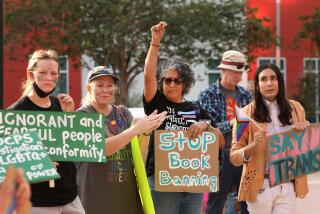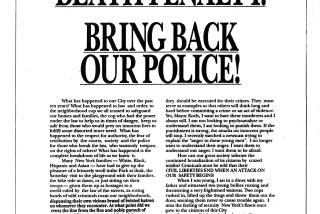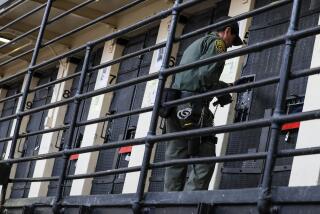King Jury Reflects Growing Impact of Racial Diversity : Courts: Public perception that a panel has been fairly drawn is now seen as essential in highly charged cases.
- Share via
During deliberations in the first Rodney G. King beating trial in Simi Valley, jurors found themselves debating the meaning of the “Gorillas in the Mist” computer message that Officer Laurence M. Powell sent after handling a dispute involving an African-American couple.
“I made the point . . . that Powell’s remarks were racist,” recalled one juror, a 38-year-old computer programmer. “I had no reasonable explanation other than that.”
But other jurors belittled the notion. “They weren’t convinced they were racial slurs,” he said, “so they couldn’t take that into account.”
Experts on jury dynamics say the debate probably would have been resolved differently if African-Americans had been on the Simi Valley panel, that they probably would have laughed off any suggestion that the “Gorillas” comment was not racist.
Because of the assumption that juror diversity would have altered such deliberations--if not the verdict--the issue of race dominated the two-week jury selection in the current King civil rights trial in Los Angeles federal court. Everyone was keeping a score card until a new panel was in place. The tally: nine Anglos, two African-Americans, one Latino.
Legal experts and decades of social studies suggest that it is risky to make sweeping assumptions about the behavior of jurors based on their ethnic status once they enter the high-pressure sanctuary of the courtroom. The U.S. Supreme Court has wavered between positions, declaring sometimes that race can make a crucial difference in juries, other times saying that race should play no role in picking them.
But there is widespread agreement on one point: After the Los Angeles riots the public perception of a fairly drawn panel has become an essential starting point in any racially charged case in the United States.
“Whether you’re a court clerk or a judge or you’re the mayor of Los Angeles . . . for all kinds of practical reasons, you very much want a jury that shows a nice racial mix,” said Emory University law professor Andrew Kull. “Because if it’s not there, the case is a guaranteed loser”--in the eyes of the public.
It was not until 1880 that the Supreme Court invalidated state laws that restricted jury service to white males. With an eye on the plight of black defendants facing Southern all-white juries, embittered by Reconstruction, the court acknowledged “that prejudices often exist against particular classes in the community, which sway the judgment of jurors.”
Decades later, juries still overwhelmingly reflected the white middle class. Jury pools were drawn from voting rolls, then sifted to find those with time to serve--generally leaving retirees, homemakers and the like.
It took much of a century for the court to push the door open a little further, ruling in 1975 that jury lists must reflect a fair cross-section of the communities from which they are drawn. The ruling--again suggesting that the race of jurors could make a difference--prompted some states to expand the list of names by reaching out to driver registration rolls and welfare lists.
But having a more diverse jury pool did not guarantee that the panels would be ethnically mixed. The key was the in-court selection process, in which prosecutors and defense attorneys could reject potential jurors one at a time, some “for cause”--if a potential juror knew one of the parties, for instance--or through peremptory challenges. This type of challenge provided broad leeway to eliminate jurors whom lawyers just did not like. That is where the debate soon focused.
Picking jurors has long been considered as much an art as a science, with lawyers relying on their gut instincts as much as anything. Some resort to idiosyncratic methods, such as the New Jersey attorney who swore by phrenology--asking to feel bumps on potential jurors’ heads. But broad assumptions based on ethnicity or religion also have been a staple of sizing up the candidates.
Clarence Darrow, the legendary trial lawyer, commented in the 1930s how Irishmen and Jews, prominent minorities of the time, would “prove more sympathetic and lenient to a defendant.” Guidebooks for lawyers taught that Southern Europeans, such as Italians, were emotional and likely to lean toward plaintiffs in civil cases.
In 1986, the Supreme Court began frowning on such rationales for picking jurors. The justices said prosecutors could not strike someone merely based on an intuition that they might be partial to the defendant “because of their shared race.” There had to be “some actual showing,” brought out through questioning of the panelists, that they were prejudiced.
The court seemed offended by racial characterizations, although some conservative justices pleaded that there was a practical basis for them. Chief Justice Warren Burger said peremptory challenges allowed “the covert expression of what we dare not say but know is true more often that not,” that jurors would be more sympathetic to members of their own race.
Studies of the jury process tended to bear him out.
A 1976 project gave 208 whites summaries of a murder trial in which only one detail was changed--the race of the defendant. The mock jurors found the black defendant guilty 69% of the time, and the white defendant guilty 54% of the time.
A 1979 study at Memphis State University created 10 mock juries: some all white, some all black, others mixed. The panels were shown videotapes of a trial in which a young man was charged with assaulting a police officer. Again, the suspect was black half the time, white the other half.
When white “jurors” were polled individually on a first ballot, none voted the white defendant guilty, while 68% judged the black guilty.
Black “jurors” were more even in their judgments--35% believed that the white defendant was guilty while 28% favored convicting the black.
But the author of the study, psychologist J.L. Bernard, noted how difficult it was for mock courts to duplicate the intensity of real jury deliberations. Even in Bernard’s study, when the ballots were discarded and the deliberations began, many who had voted for convictions began to soften their positions.
In fact, after the deliberations, the only “jury” to render a guilty verdict was the all-white panel judging the black defendant. A sobering note was provided by a panel of six whites and six blacks, which wound up deadlocked--split exactly along racial lines--in judging the black defendant.
Bernard and others suggest that the message of such studies may not be so much the racial prejudice of whites, but that “black jurors as a whole (may) be more likely to acquit a defendant, regardless of race,” being more suspicious of police witnesses.
Courtroom veterans, however, know to look beyond the leanings of a group in sizing up jurors. Although defense lawyers in the King civil rights trial were believed to be looking for conservative whites, one young black in the jury pool also caught their eye: his mother had worked for the Sheriff’s Department, he once had done a “ride-along” to see what police work was like and his recent reading material included the autobiography of . . . Daryl F. Gates.
High-priced jury selection specialists were not needed to chalk up this black man--who wound up as an alternate juror--as a likely friend of law enforcement.
It was in the wake of the explosive Simi Valley trial last year that the Supreme Court issued its latest decision on juries and race. Ruling in June on a Georgia case in which three white men were charged with assaulting a black couple, the court prohibited defense attorneys from systematically striking blacks from the jury--unless they could show a reason for challenges other than race.
While the same standard had been imposed on government prosecutors in 1986, it was startling to many that the court would so limit the strategy of defendants, whose liberty--even their lives--could be at stake.
But Justice Harry A. Blackmun wrote that another interest was at stake--society’s perception of the fairness of the courts.
“In such cases,” he said, “public confidence in the integrity of the criminal justice system is essential for preserving community peace.”
In an implicit acknowledgment of that reality, defense attorneys in the King civil rights case seemed relieved this month when they quickly found a black juror they were comfortable with: Juror 7, a female postal worker about 30 years old who admitted that she was shocked with the Simi Valley acquittals but that she believed the jurors did their best.
“I want her on my jury!” said Harland W. Braun, who represents Officer Theodore J. Briseno. “I like her. She’s a good juror!
“I think we’re going to have an ethnically balanced jury.”
Soon after, however, all the racial tensions of the city were back in play. It happened after a prospective juror--a white who was dismissed--alleged that the woman had been disdainful in private comments about the defense.
There were motions to dismiss her and a volley of charges between the prosecution and defense that each side was making racially motivated jury selections. Finally, just before opening statements were to begin, defense attorney Paul DePasquale expressed fears that there might be a Trojan Horse of sorts on the jury being asked to make the most closely watched verdict in the city’s memory.
“It’s almost as if people auditioned,” he said of the extended jury process, fearful that a juror with a hidden agenda “knew what to say” and slipped through.
But at 10:47 a.m. on Thursday, Davies denied the motion for a mistrial and declared: “Ladies and gentlemen, you are now the jury in this case.”
More to Read
Sign up for Essential California
The most important California stories and recommendations in your inbox every morning.
You may occasionally receive promotional content from the Los Angeles Times.










